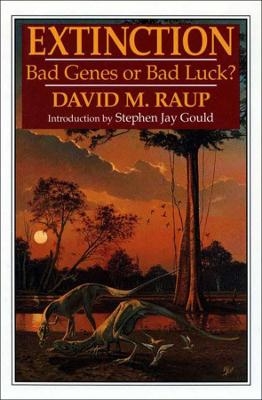
Extinction
WW Norton & Co (Verlag)
978-0-393-30927-0 (ISBN)
- Lieferbar (Termin unbekannt)
- Versandkostenfrei innerhalb Deutschlands
- Auch auf Rechnung
- Verfügbarkeit in der Filiale vor Ort prüfen
- Artikel merken
In the geological record, there are five major mass extinctions—the "Big Five." The most famous happened at the end of the Cretaceous Period, when the dinosaurs and two-thirds of all marine animal species were wiped out, opening the door for the age of mammals and the rise of Homo Sapiens. Using this example as a springboard, David M. Raup leaps into an egaging discussion of the theories, assumptions, and difficulties associated with the science of species extinction. Woven is along the way are stories of the trilobite eye, tropical reefs, flying reptiles, and the fate of the heath hen on Martha's Vineyard, a very modern extinction.
David M. Raup is the Sewell Avery Distinguished Service Professor and a statistical paleontologist at the University of Chicago. Stephen Jay Gould (1941-2002) was the Alexander Agassiz Professor of Zoology and Professor of Geology at Harvard University. He published over twenty books, received the National Book and National Book Critics Circle Awards, and a MacArthur Fellowship.
Part 1 Almost all species are extinct: is extinction important? bad genes or bad luck? the nature of extinction; who studies extinction? a word about the word; species defined; the purpose of extinction, if any. Part 2 A brief history of life: origin of life; complex life; the quality of the fossil record; 600 million years of fussing; a stock market analogy; trilobite eyes; tropical reefs; flying reptiles; human evolution; living fossils. Part 3 Gambler's ruin and other problems: gambling; concepts of randomness; gambling for survival; differing extinction and speciation rates; skewed histograms; other models; a note on extinction of surnames. Part 4 Mass extinctions: the K-T mass extinction; measuring extinction; a note on killing; duration of mass extinctions; do mass extinctions differ from background; the kill curve. Part 5 Selectivity of extinction: Ice Age Blitzkrieg; selectivity of the Blitzkrieg; body size and the K-T extinction; other examples of bias; other examples of selectivity; the Trilobites' bad genes; some implications; summary. Part 6 The search for causes: the rarity of extinction; just so stories; beware of anthropomorphism!; the kill curve revisited. Part 7 Biological causes of extinction: are species and ecosystems fragile? the case of the heath hen; importance of the first strike; problems of small populations; competition; species-area effects; species-area and past extinctions; the great American interchange; the history of tropical rain forests. Part 8 Physical causes of extinction: traditional favourites; sea level and climate; species-area effects; testing sea level and climate; the Pleistocene experience; exotic physical causes; unheard-of volcanism; cosmic causes. Part 9 Rocks falling out of the sky: cratering rates; destructive power; Alvarez and the K-T extinction; periodicity of extinction and nemesis. Part 10 Could all the extinctions be caused by meteorite impact? plausibility arguments; arguments from observation; extinctions are linked to craters; extinctions are not linked to craters; assessment. Part 11 Perspectives on extinction: how to become extinct; wanton extinction; the role of extinction in evolution; bad genes or bad luck?; a note on extinctions today. Epilogue: did we choose a safe planet?.
| Erscheint lt. Verlag | 6.1.1993 |
|---|---|
| Einführung | Stephen Jay Gould |
| Sprache | englisch |
| Maße | 140 x 208 mm |
| Gewicht | 290 g |
| Themenwelt | Naturwissenschaften ► Biologie ► Evolution |
| Naturwissenschaften ► Geowissenschaften ► Mineralogie / Paläontologie | |
| ISBN-10 | 0-393-30927-4 / 0393309274 |
| ISBN-13 | 978-0-393-30927-0 / 9780393309270 |
| Zustand | Neuware |
| Haben Sie eine Frage zum Produkt? |
aus dem Bereich


